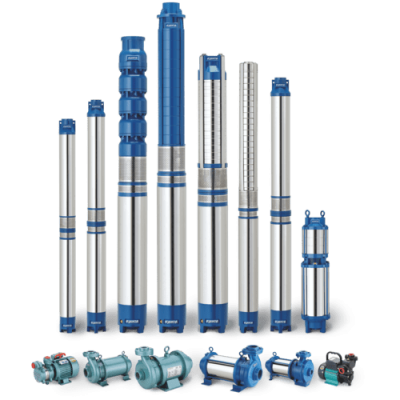Project Report For Submersible pumps
Introduction
Project Report for Submersible pumps is as follows.
A submersible pump is a machine with a hermetically sealed motor that is close to the pump body (sometimes referred to as an electric submersible pump, or ESP). The pumped fluid surrounds the entire apparatus. The primary benefit of this type of pump is that it eliminates pump cavitation, which is produced by a considerable elevation difference between the pump and the fluid surface. In contrast to jet pumps, which create a vacuum and rely on air pressure, submersible pumps drive fluid to the surface. Instead of an electric motor, submersibles employ pressurised fluid from the surface to power a hydraulic engine downhole.
Electric submersible pumps are vertical multistage centrifugal pumps. The kinetic energy of the liquids propelled by the impeller is transferred to pressure energy in the diffuser. This is the basic working mechanism of radial and mixed flow pumps. The motor in the HSP is a hydraulic motor rather than an electrical motor, and it can be closed cycle (keeping the power fluid separate from the generated fluid) or open cycle (mingling the power fluid with the produced fluid downhole while maintaining surface separation).
A mechanical coupling is located at the base of the pump and connects the pump shaft to the gas separator or protector. Through an intake screen, fluids are introduced to the pump, where the pump stages raise the fluids. Other components include radial bearings (bushings) that run the length of the shaft and provide radial support to the pump shaft. An optional thrust bearing absorbs some of the axial forces generated by the pump, while the protector’s thrust bearing absorbs the majority of those forces.

Types Of Submersible Pumps
Deep Well Submersible Pumps: These pumps are intended for use in deep water sources such as wells or boreholes. They feature a large shaft to reach the water source and can pump water from great depths.
Submersible Pumps for Sewage: These pumps are particularly intended to handle wastewater, sewage, or effluent. They have solid-handling capabilities and are often utilised in municipal or industrial sewage systems.
Fountain Submersible Pumps: These pumps are intended to be attractive in fountains, waterfalls, or pond features. They are generally small in size and come with variable flow rates and nozzles to produce desired water effects.
Sump Submersible Pumps: Sump pumps are used to drain water from sump pits or flooded basements. They are frequently outfitted with float switches that activate as the water level rises.
Drainage Submersible Pumps: These pumps are used to remove water from building sites, basements, or swimming pools. They can handle big amounts of water and are frequently built to last.
Stainless Steel Submersible Pumps: Because they are made of stainless steel, these pumps are ideal for applications requiring corrosion resistance. They are typically employed in settings involving seawater, saltwater, or chemical handling.
Market Potential Of Submersible Pumps
The submersible pumps market was worth around USD 11.12 billion in 2020, and it is predicted to grow to USD 17.11 billion by 2027, at a CAGR of 5.5% from 2022 to 2027.
The market is likely to continue growing in the future, owing to factors such as rising need for clean water, rapid urbanisation, and increased investment in infrastructure development projects. One of the significant market drivers is the rising need for dependable water supply systems across various end-use industries.
Submersible pumps are frequently used in the agricultural sector for irrigation, the oil and gas sector for drilling and exploration, and the mining sector for dewatering. The market is rising because there is a greater need for submersible pumps in residential and commercial buildings for drainage and water supply systems.
The revenue produced by the industrial segment of the submersible pump market is predicted to rise steadily till 2023., demand for submersible pumps increased by 2.8% between 2028 and 2022, indicating a favourable market rebound.
Farmers in the agricultural industry have been quick to adopt technology-driven equipment such as heavy-duty submersible pumps for water supply. Municipal water distribution and wastewater treatment are likely to increase at a rapid pace in the next few years, supporting the worldwide market’s expansion.
Project Report Sample On Submersible Pumps
Need Help?
Create 100% Bankable Project Report

